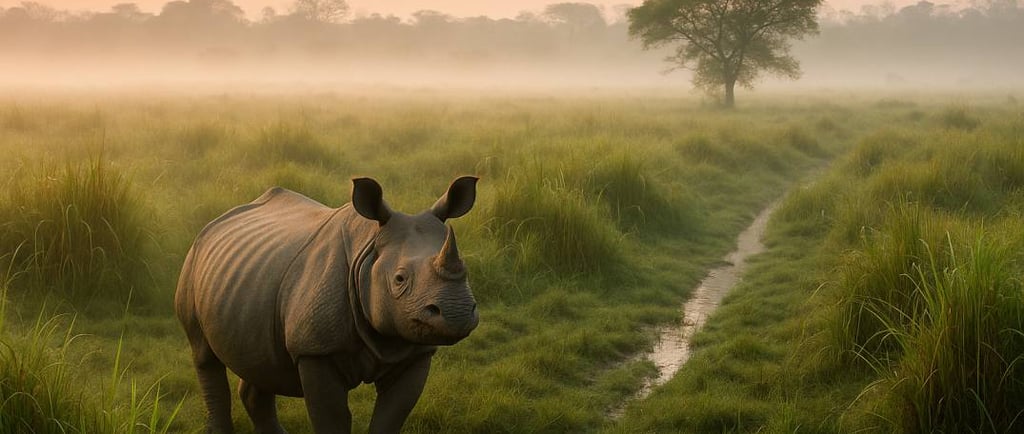My Journey into Kaziranga National Park
Discover the magic of Kaziranga National Park! Immerse yourself in the wild heart of Assam, witness the iconic one-horned rhino, and explore a vibrant ecosystem. Plan your unforgettable safari adventure today.
ASSAM


There are places on Earth that don't just exist; they breathe, they whisper stories, and they leave an indelible mark on your soul. Kaziranga National Park in Assam, India, is one such place. It's more than just a wildlife sanctuary; it's a living, thrumming testament to resilience, a symphony of wild beauty, and a powerful reminder of our intrinsic connection to the natural world.
The Dawn Chorus: A First Encounter
I remember the crisp, early morning air as we set out for our safari. The first sliver of dawn was just painting the eastern sky in hues of soft pink and orange, casting a gentle glow over the landscape. A cool, damp mist still clung to the impossibly tall elephant grass, making the world feel ethereal, almost otherworldly. The air was thick with the earthy scent of damp soil and wild foliage, mingled with the faint, sweet perfume of unseen blossoms.
The jungle was waking up around us, a symphony of unseen creatures stirring. The distant hoot of an owl, the chattering of monkeys beginning their day, and the rhythmic drone of insects created a unique, natural soundtrack. My heart thrummed with a quiet anticipation, a profound sense of being on the cusp of something truly magical.
And then, through the wisps of fog, a shadow emerged, solid and ancient. A magnificent, prehistoric silhouette moved with surprising grace. It was a one-horned rhinoceros, grazing peacefully, its powerful frame a picture of quiet dignity against the burgeoning light. Its single horn, a beacon of its species, seemed to glow in the nascent sun. In that moment, the world seemed to hold its breath. It wasn't just seeing an animal; it was witnessing a miracle, a creature brought back from the brink of extinction thanks to decades of unwavering dedication. This, right here, is the beating heart of Kaziranga's remarkable story.
More Than Just Rhinos: A Tapestry of Life and Resilience
While the majestic one-horned rhino is undoubtedly Kaziranga's most iconic resident a living symbol of its conservation success the park is a vibrant ecosystem teeming with life, a truly diverse tapestry. As our jeep navigated the winding, dusty trails, each turn revealed a new wonder. We encountered herds of majestic Asian elephants, their colossal yet gentle forms moving with an almost silent grace through the tall grass, their ancient eyes reflecting the wisdom of the wild. Wild water buffaloes, with their impressive, sweeping crescent-shaped horns, wallowed contentedly in the marshlands, their powerful bodies blending seamlessly with the muddy banks. And the elegant swamp deer (barasingha), with their distinctive multi-tined antlers, darted through the grasslands, their delicate movements a stark contrast to the power of their larger neighbors.
And then there's the elusive phantom of the jungle the Royal Bengal Tiger. Though spotting one is a rare privilege, a moment of pure serendipity, the thrill of knowing they roam these very grounds adds an undeniable edge to the experience. Our guide, Mr. Singh, with eyes honed by years in the wilderness, would occasionally point out subtle signs fresh pugmarks impressed in the soft earth, a tell-tale territorial scrape on a tree trunk, or the sudden alarm call of a deer. These silent clues were enough to send a shiver of excitement down my spine, a visceral connection to the wildness that truly defines this place.
For birdwatchers, Kaziranga is an unparalleled paradise. The air is alive with the calls of countless avian species from the vibrant flashes of iridescent kingfishers diving into tranquil waters to the stately presence of various storks wading elegantly through the wetlands. During the winter months, the park transforms into a vital sanctuary for countless migratory birds, turning the wetlands into a kaleidoscope of feathers and a symphony of chirps, squawks, and rustles. It's a natural orchestra that transports you far from the concrete jungles of human existence, urging you to simply breathe and listen.
The Guardians of Kaziranga and a Legacy of Hope
What truly makes Kaziranga special, beyond its breathtaking biodiversity, is the profound human touch the unwavering commitment of those who have dedicated their lives to protecting it. Kaziranga's story is one of an incredible turnaround. In the early 20th century, the rhino population here was desperately low, estimated to be just a few dozen. It was the visionary efforts, notably of Lady Curzon, who championed its protection, leading to its declaration as a reserve forest in 1908 and a national park in 1974.
Today, you hear inspiring stories of the forest guards, often called "Van Durgas" (Forest Goddesses), who brave the harsh elements, the constant threat of poachers, and the sheer isolation of the wilderness. They patrol tirelessly, day and night, working with an almost spiritual dedication to safeguard these precious lives. Their bravery, resilience, and often silent sacrifices are truly humbling, a powerful reminder of what we can achieve when we stand united for a cause greater than ourselves.
I learned about the rigorous anti-poaching measures, the sophisticated intelligence networks, and the incredible risk these brave men and women undertake. But it's not just about protection; it's also about community. The park's success is deeply intertwined with the involvement of local communities, who are empowered to become stakeholders in conservation through various initiatives, from eco-tourism to sustainable livelihoods. This holistic approach, combined with cutting-edge scientific research that helps understand and nurture this delicate ecological balance, makes Kaziranga not just a success story in wildlife conservation but a leading global model of human-wildlife coexistence.
Planning Your Own Kaziranga Encounter: Important Information & Ethical Considerations
If you're feeling the undeniable pull of the wild, a whisper from the heart of Assam, here's what you need to know to experience Kaziranga's magic for yourself. Be prepared for an adventure that will engage all your senses and deepen your appreciation for our planet's wild wonders:
Best Time to Visit: The prime season for a visit is from November to April. During these months, the weather is pleasantly cool and dry, making safaris comfortable. More importantly, the receding floodwaters concentrate animals near accessible water sources, significantly increasing your chances of wildlife sightings. The Park remains closed from mid-May through October due to heavy monsoon rains and potential flooding, which makes the terrain impassable and the risk to both humans and animals too high.
Getting There:
By Air: The nearest airports are Jorhat Airport (Rowriah), approximately 97 km away, and Tezpur Airport (Salonibari), around 75 km away. Both have good domestic connectivity. For international travelers, or those preferring a larger hub, Guwahati's Lokpriya Gopinath Bordoloi International Airport (GAU) is a major airport, about 225 km from Kaziranga, with excellent connectivity across India and some international routes. From these airports, you can easily hire taxis or pre-booked transfers to reach the park.
By Rail: The nearest convenient railway stations are Furkating (FKG), approximately 75 km away, and Jakhalabandha (JKB), about 45 km away. However, for better connectivity, many visitors opt for Guwahati Railway Station, which is a major junction and then proceed by road.
By Road: Kaziranga is remarkably well-connected by road from major cities in Assam. National Highway 37 passes right through the park, making access straightforward. State-run buses and private taxis are readily available from Guwahati, Jorhat, and Tezpur.
Safari Zones: Your Gateway to Discovery: The Park is divided into four main safari zones, each offering a unique perspective and different chances of sightings. It's often recommended to explore at least two or three to get a comprehensive experience:
Kohora (Central Range): This is the most popular and easily accessible range, known for its high density of rhinos and elephants. It's often the starting point for first-time visitors due to its well-maintained trails and good chances of spotting iconic wildlife.
Bagori (Western Range): Famous for its expansive grasslands and marshlands, this range is excellent for spotting rhinos, wild water buffaloes, and a wide variety of birdlife. The landscape here feels particularly vast and wild.
Agaratoli (Eastern Range): A true birdwatcher's paradise, this zone is characterized by its numerous water bodies and lush forest cover. While still offering chances to see elephants and rhinos, its serene environment and abundant avian life make it a quieter, more contemplative safari experience.
Burapahar (Ghorakati Range): Located further west, this range is unique for its hilly terrain and offers opportunities for guided trekking (with permission and a forest guard), providing a different kind of wilderness immersion and a chance for unique sightings.
Safari Options: Choose Your Adventure:
Jeep Safaris: Available in all zones, jeep safaris offer a comfortable and relatively fast way to explore the park's diverse habitats. They allow you to cover more ground and delve deeper into specific areas. Jeep safaris are booked on the spot or through your accommodation.
Elephant Safaris: Primarily conducted in the Central (Kohora) and Western (Bagori) Zones, elephant safaris offer an incredibly intimate and unique wildlife encounter. Perched high atop a gentle giant, you can often get much closer to animals, especially rhinos, as they remain undisturbed by the elephant's presence. These safaris typically take place in the early morning and are immensely popular. Booking in advance is highly recommended, especially for elephant safaris, as availability is limited. Many hotels can assist with bookings.
Ethical Safari Tips for a Deeply Human Connection:
Respect the Wild: Remember, you are a guest in their home. Maintain a respectful distance from animals and never attempt to approach them. Their safety and well-being are paramount.
Listen to Your Guide: Your forest guide and driver are experts. They understand animal behavior and the park's rules. Follow their instructions diligently for your safety and the well-being of the wildlife. They will often point out things you might otherwise miss.
Keep Quiet: Loud noises, shouting, or playing music can disturb animals and ruin the experience for others. Embrace the profound silence of the jungle; it allows you to truly immerse yourself.
No Feeding: Never, ever feed wild animals. It disrupts their natural behavior, makes them dependent on humans, and can be harmful to their health.
Stay on Designated Paths: Do not venture off the marked safari trails. This protects the fragile ecosystem and ensures your safety.
Carry Your Trash Out: Leave no trace behind. All plastic bottles, wrappers, or any waste must be carried out of the park with you. Kaziranga is a plastic-free zone.
Binoculars and Camera: Essential tools for capturing the magic without disturbing the wildlife. A good zoom lens for your camera will allow you to get incredible shots from a safe distance.
Dress Appropriately: Wear comfortable, earthy-toned clothing that blends with the environment. Layers are advisable as morning temperatures can be cool and midday can be warm.
Support Local and Sustainable: Choose ethical tour operators and accommodations that actively contribute to local communities and conservation efforts. Your visit can directly impact the well-being of the park and its people.
Kaziranga National Park is not just a destination; it's an experience that awakens something primal within you, a profound sense of wonder and connection to the wild heart of our planet. It’s a reminder of the extraordinary beauty that still exists in our world, and the powerful, shared responsibility we have in preserving it for generations to come. So, if your heart yearns for a whisper of the wild, if you long to witness resilience and raw beauty, let Kaziranga call to you. You won't just see nature; you'll feel it, in every rustle of the elephant grass, every distant call of a bird, and every silent, powerful gaze from a one-horned giant. It's a journey that will stay with you, long after you've left its emerald embrace, echoing in your memory like a wild, unforgettable song.
Read also: Top 10 Places in Assam
